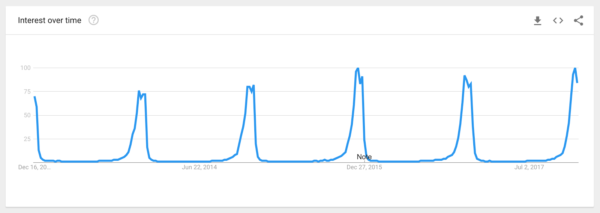— December 22, 2017

coffeebeanworks / Pixabay
To build a sustainable, profitable, scalable ecommerce business in 2018, you need to understand the ins and outs of managing inventory. Poor inventory management can be a complex challenge to overcome for any ecommerce entrepreneur, no matter your expertise, the size of your business, the types of products you sell, or the audience you serve.
As you wrap up the holiday shopping season, or as you work through plans for launching a new ecommerce in the coming year, you’re likely thinking a lot about how to approach and optimize inventory management.
Making the wrong choices when it comes to how you manage inventory can be incredibly costly. Making the right choices can be incredibly profitable.
So, what do you need to know to be successful in the year ahead?
This article will provide you with a brief overview on inventory management. We’ll start by highlighting a few terms you need to know, then we’ll detail some of the challenges that ecommerce business owners face, and finally, we’ll wrap up by providing you with a handful of actionable best practices and recommendations that you can use to build or optimize an effective inventory management strategy for your business.
Glossary
Before we dive too deep into how to optimize inventory management, it’s helpful to first understand some of the terminology and concepts that you’ll encounter along the way. Here’s a list of 17 words and phrases you should become more familiar with:
Inventory: tangible items, products, or goods that you intend to sell to customers.
SKUs: a stock keeping unit (SKU) is an identification code that you use to classify and organize products.
Variants: variations of the same product, such as a different color.
Units of Measure: whatever you use to measure your stock (items, pieces, bundles, kilograms, ounces, etc.).
Dead Stock: Inventory that you have in stock, but can’t necessarily sell anymore.
Supply Chain: the processes and systems involved in producing, managing, and distributing product.
Minimum Viable Stock: The minimum amount of product you need to have on hand in order to keep up with consumer demands and fulfill orders without delay.
First In First Out (FIFO): Shopify defines FIFO as, “an accounting method assumes that sellable assets, such as inventory, raw materials, or components acquired first were sold first. That is, the oldest merchandise is sold first, with its associated costs being used to determine profitability.”
ABC Analysis: a method for prioritizing your existing inventory using three categories: (A) high-value products with a low frequency of sales; (B) moderate value products with a moderate frequency of sales; (C) low value products with a high frequency of sales.
Dropshipping: a fulfillment method where you don’t actually store any inventory onsite. Instead, orders are fulfilled and inventory is shipped directly from a third party to the customer.
Just-in-Time (JIT): a fulfillment method where inventory orders are made just in time to keep up with demand from consumers. This method allows you to avoid tying up money with unsold inventory, but creates potential risk in not being able to fulfill a sudden surge of orders.
Centralized Inventory Control: software that allows to you to easily manage, track, and control inventory across multiple ecommerce websites like Amazon, Ebay, Etsy, and others.
Cost of Goods Sold (COGS): Intuit describes COGS as, “is an accounting item reported on the income statement that details the total costs of the products or merchandise sold by a business and considered an expense during a reporting period.”
Carrying Cost/Holding Cost: the cost of holding your inventory in a year versus the value of the inventory itself.
Inventory Auditing: the act of manually counting or checking inventory to ensure that it matches the numbers that exist within your tracking and automation systems.
Inventory Forecasting: making informed decisions about ordering and reordering products based on historical data, trends, and seasonality in your business.
Inventory Management Software: tools that help you track inventory, streamline processes, automate tedious tasks, and leverage data and other insights to boost success.
Understanding these words and concepts will ultimately help you become more informed and strategic when it comes to managing and optimizing inventory management processes and tasks at your business.
Challenges
Every ecommerce business owner encounters inventory management challenges at one point or another. Knowing what some of these challenges are ahead of time and how to address them is what separates the good from the great.
Here are some of the most common inventory challenges that can ultimately affect the growth and profitability of an ecommerce business:
Challenge #1: Overstocking & Overselling
In ecommerce, if you don’t have a good grasp on your inventory and the shopping habits of your target audience, it can be easy to fall into situations where you either can’t supply demand, or you’ve over-estimated how much product you actually need to have on hand in a given month.
Although it can be advantageous to keep a large supply of inventory on hand, especially as you approach a busy season, it can present some challenges: First, it can be expensive. Unless you’re dropshipping inventory, you’ll need to store the products you order from manufacturers. As you can imagine, too much inventory and not enough orders can wreak havoc on your ability to come out ahead at the end of the month.
Second, when you have too much inventory and not enough demand, you’re presented with the risk of having too much dead stock on hand. As mentioned earlier, dead stock refers to inventory that you basically can’t sell. It happens when products perish or deteriorate over time, but it can also happen as trends and shopping behaviors shift.
On the flip side, not having a good pulse on your inventory can also result in accidental overselling—i.e. letting customers buy products that are out of stock. When you oversell product, you create customer service and reputation challenges that can take time to overcome and repair. These days, consumers want transparency when it comes to working with ecommerce brands, They want to be able to know and trust that if you make a promise, you’ll keep your word. When you oversell inventory, you risk delaying fulfillment and potentially damaging the trust you built up with people who chose to order your product.
Challenge #2: Manual Management That Doesn’t Allow For Scale
Another challenge that many ecommerce business owners face relates to scale. When you’re in the early stages of building your ecommerce business, it’s relatively easy (and tempting) to manually track and fulfill orders, even across multiple channels. But it become much, much more difficult as you work to scale your business in order to meet the growing demands of your customer base.
For many ecommerce business owners, scaling means selling products on additional channels, such as places like Amazon, Etsy, Ebay, Alibaba, and others. It also means working with multiple partners, vendors, and manufacturers. It might even mean storing inventory at multiple warehouses around the country. Taking such steps to grow your ecommerce business in this way is next to impossible when you rely only on manual management methods.
Some examples of ineffective manual inventory management methods include:
- Using offline spreadsheets to track inventory numbers
- Using a suite of separate tools that aren’t integrated or synced with each other
- Using an offline program that can’t provide you with automatic real-time updates
- Using a paper and pencil to manually track and fulfill orders
When you’re just starting out in the world of ecommerce, it can be tempting to track and manage inventory manually in order to save money and keep a hand on every aspect of your business. In order to avoid and prepare for some of the challenges mentioned above, however, it’s important that you take the time to investigate and make plans to adopt more scalable inventory management processes, tactics, and tools that support continued growth over time.
Challenge #3: Lack of Visibility Across Multiple Channels & Multiple Warehouses
Lack of visibility is another common problem that ecommerce business owners tend to face as product demand increases and inventory management becomes more complex. There are two main visibility challenges that can impact your ability to meet demand and grow your business:
The first is a lack of visibility across multiple channels. As mentioned above, as you grow your ecommerce business, you’ll likely decide to start selling your products across multiple channels (Amazon, Etsy, Ebay, etc.). The problem is, unless you’re using inventory management software, it’s not always easy to keep track of the sales and orders that come in from each channel, and how those sale and orders are impacting the inventory you have on hand.
The second is a lack of visibility across multiple warehouses. As your business grows, you might find yourself partnering with more manufacturers and warehouses in order to meet the growing demands of your customers. Your goal is to have inventory on-hand and accessible when demand suddenly increases. But again, without inventory management software in place, trying to keep track of orders, inventory, and relationships across all warehouses, partners, and manufacturers can be a dizzying process for anyone.
Without complete visibility across your entire inventory management system, it’s difficult to know which decisions need to be made and when they need to be made by in order to continue boosting sales and meeting consumer demand.
Challenge #4: Lack of Insights
The final challenge that many ecommerce business owners face relating to inventory management is lack of insights. In order to grow your business and make decisions that support demand, you need to become obsessed with data.
In order to boost profits and support growth, you need to understand things like how your inventory is fluctuating over time, how demand is changing over time and forecasting what it will look like in the future, when to reorder products, when to scale back on products, and where breakdowns in your processes are happening. Oftentimes, you need to be able to access and act upon inventory data within a day or even a few hours in order to capitalize or fully understand an emerging opportunity.
Without a centralized system that pulls inventory information from every source on a real-time, 24/7 basis, it’s virtually impossible to leverage data to make these kinds of informed decisions about your business.
Getting Started
Now that you understand some of the concepts and challenges relating to inventory management, it’s time to take action. To build an optimized inventory management system at your ecommerce business, take the following steps:
1. Understand basic product category demand. The first step in getting a better handle on inventory management, especially if you’re launching a brand new ecommerce shop, is to understand how demand fluctuates for your product category over time. You can achieve this by leveraging Google Trends to look at how search demand and interest has changed over the past 12 months, or even the past 5 years.
Here’s an obviously dramatic example showing when people are searching most often for Christmas lights throughout the year:

Showing demand over 5 years
As you can see, interest begins to grow as early as September, and peaks around mid-December. By understanding trends in this way, you can gain a better understanding of when you might want to order more or less of the products you sell.
2. Forecast future demand based on past sales. The second step in optimizing inventory management is to attempt to forecast future demand. To do this, simply look at past sales and determine when demand and interest was highest. From there, order and store inventory accordingly in order to prevent any items from going out of stock during peak times of demand. If you don’t have any sales history, refer back to the analysis you performed with Google Trends.
3. Set initial minimum viable stock, or minimal stock levels. If your ecommerce shop is already running, you should also take the time to set minimum viable stock levels for every product you sell. Remember: your goal is to determine the lowest possible inventory you can have in order to meet demand and avoid delays in fulfillment. To land on your number, you’ll need to have a good understanding of demand, and the amount of time it takes to replace out of stock inventory. When quantities dip below the number you designate, place a new order with your manufacturer or wholesaler. Think of this exercise as a starting place. Don’t be afraid to adjust this number over time as you experience growing or waning demands from consumers.
4. Prioritize products with an ABC analysis. To boost efficiency and save money, take the time to prioritize products using the ABC analysis. As mentioned above, the ABC analysis is a method for prioritizing your existing inventory using three categories: (A) high-value products with a low frequency of sales; (B) moderate value products with a moderate frequency of sales; (C) low-value products with a high frequency of sales.
Your goal here should be to understand which products need the most attention from you from an inventory management perspective. For example, products that fall underneath your A category may need to be ordered more often than products that fall underneath your C category, because the amount you keep on hand is much smaller.
5. Gear up for seasonality. If you’re running an ecommerce store that will take advantage of a particular shopping season (Christmas) or time of year (summer), do what you can to be prepared. Keep inventory levels low during slow months, but don’t wait too long to ramp up your supply. Keep costs down for as long as you possibly can, and while business is slower, use the time to make sure you have all the pieces in place (partners, tools, warehouse storage, people resources, tools, etc.) to ensure a smooth and successful sales period.
6. Implement inventory management software. In order to build and scale an ecommerce business today, you really need to invest in inventory management software. You can manually work through some of the tips outlined above, but as mentioned earlier, it’s not going to make it easy to scale your business. Inventory management software can help you keep a pulse on inventory, ensure you’re never overstocked or understocked, help you sync inventory tracking across all the channels you sell products on, compile real-time inventory data within one convenient system, and allow you to leverage valuable insights that you can use to take advantage of opportunities, boost sales, and grow your ecommerce business.
Over to You
How do you approach inventory management at your business? What challenges have you faced and been able to overcome? What learnings can you share that might help other entrepreneurs and business owners? Share your thoughts in the comments below — I’d love to hear from you!
Digital & Social Articles on Business 2 Community
(86)





